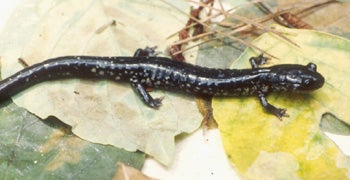SCIENTIFIC NAME:
Plethodon glutinosus (Green)
STATUS:
Part of the Slimy Salamander complex (3 species) that were formerly considered a single species, Plethodon glutinosus, these very similar species now are known to be genetically distinct. At least one representative found in every county. Identification based on appearance is impossible. P. glutinosus common. Eastern Alabama, from Southwestern Appalachians south to Fall Line Hills. Lowest Conservation Concern.
OTHER NAMES:
The Northern Slimy Salamander was once considered to be one widely distributed species in the southeastern United States. Later genetic analysis revealed 13 distinct lineages which are all currently recognized as taxonomic species (Highton, Maha, and Maxsons 1989). All 13 species are collectively referred to as the Plethodon glutinosus species complex.
DESCRIPTION:
The Northern Slimy Salamander is a medium to large, woodland salamander about 4-7.5 inches long. Like other salamanders of the complex, the Northern Slimy Salamander is black to bluish-black. Individuals have numerous, large, white -brassy spots on the back and tail. They are moderately spotted on their sides. The degree of spotting and flecking varies among individuals. The Northern Slimy Salamander generally has white spotting on the chin and throat with a uniformly dark belly.
DISTRIBUTION:
The Northern Slimy Salamander is a widely distributed species. It ranges extends throughout Kentucky, West Virginia, Pennsylvania, southern Illinois, southern and western Indiana, eastern Ohio, Tennessee, northeastern Alabama, northern Georgia, southwestern North Carolina, Virginia, Maryland, New Jersey, southwestern Connecticut, New York, and parts of New Hampshire (Lannoo 2005). In Alabama, the Northern Slimy Salamander is generally restricted to regions east of the Fall Line and north of the Coosa River Valley.
HABITAT:
Northern Slimy Salamanders are common to forested areas. Individuals can be found in maritime and river-bottom hardwood forests. They reach greater densities in mature hardwood forests versus pine forests. They may also be found in caves. Individuals of this can be encountered under rotting logs, fallen branches, rocks, and in rock crevices.
LIFE HISTORY AND ECOLOGY:
Breeding in the Northern Slimy Salamander is terrestrial with the offspring undergoing direct development (e.g, developing without a free-living, aquatic larval stage). Males will court the females using chemical, tactile, and visual cues. Timing of reproduction varies geographically with latitude; therefore, breeding may occur March-October depending on location. Fertilization is internal and females will lay a cluster of 1-33 eggs that are suspended from the roof of a small cavity in the ground, under rocks and logs, or in caves and crevices in open cliff faces. Females will attend the eggs through development, 2 -3 months. Females will remain with the young until they disperse from the nest in 2-3 weeks.
Adult Northern Slimy Salamanders are likely to establish and defend small territories from other slimy salamanders and other terrestrial salamander species (Cunningham et al. 2009; Mitchell & Gibbons 2010). Territories are often established in and around burrows and root tunnels. Northern Slimy Salamanders use burrows as refuges to escape hot, dry condition during summer months and for protection from predators. Adults will often forage at the mouth of the burrow and ambush passing prey. Females may also use burrows as brooding sites. Foraging may occur on the surface at night or during warm, rainy periods; however, individuals typically do not travel far from their burrows.
As a defense mechanism the Northern Slimy Salamander will secrete noxious, sticky mucus from glands in the tail.
BASIS FOR STATUS CLASSIFICATION:
The Northern Slimy Salamander is common within its range.
REFERENCES:
Cunningham, H. R., Rissler, L. J. & Apodaca, J. J. (2009) Competition at the range boundary in the slimy salamander: using reciprocal transplants for studies on the role of biotic interactions in spatial distributions. Journal of Animal Ecology, 78, 52-62.
Highton, R., Maha, G. C. & Maxson, L. R. 1989. Biochemical evolution in the slimy salamanders of the Plethodon glutinosus complex in the Eastern United States. University of Illinois Press, Urbana.
Lannoo, M. 2005. Amphibian declines: The conservation status of United States species, University of California Press, Berkeley.
Mitchell, J., & Gibbons, W. 2010. Salamanders of the Southeast. The University of Georgia Press, Athens.
Pentranka, J. (1998). Salamanders of the United States and Canada. Smithsonian Institution Press. Washington, DC
AUTHOR: Heather R. Cunningham, Alabama Partners in Amphibian and Reptile Conservation






